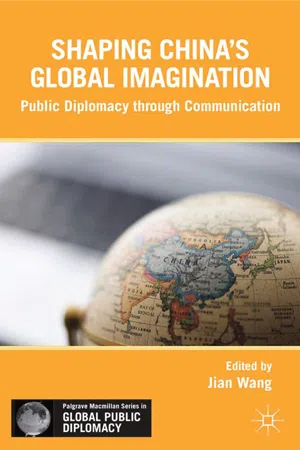
This is a test
- English
- ePUB (mobile friendly)
- Available on iOS & Android
eBook - ePub
Book details
Book preview
Table of contents
Citations
About This Book
A comprehensive discussion of how countries embrace branding as a crucial element in their pursuit of soft power and why certain nation-branding efforts succeed while others fail through the example of the 2010 World Expo in Shanghai.
Frequently asked questions
At the moment all of our mobile-responsive ePub books are available to download via the app. Most of our PDFs are also available to download and we're working on making the final remaining ones downloadable now. Learn more here.
Both plans give you full access to the library and all of Perlego’s features. The only differences are the price and subscription period: With the annual plan you’ll save around 30% compared to 12 months on the monthly plan.
We are an online textbook subscription service, where you can get access to an entire online library for less than the price of a single book per month. With over 1 million books across 1000+ topics, we’ve got you covered! Learn more here.
Look out for the read-aloud symbol on your next book to see if you can listen to it. The read-aloud tool reads text aloud for you, highlighting the text as it is being read. You can pause it, speed it up and slow it down. Learn more here.
Yes, you can access Shaping China's Global Imagination by J. Wang in PDF and/or ePUB format, as well as other popular books in Social Sciences & Sociology. We have over one million books available in our catalogue for you to explore.
Information
N O T E S
Chapter 1
1.Maurice Roche, Mega-events and Modernity: Olympics and Expos in the Growth of Global Culture (London: Routledge, 2000), 1.
2.The Bureau International des Expositions also sponsors a specialized international exposition in between the two World Expos. We explain these two categories of events in chapter 3.
3.Daniel Dayan and Elihu Katz, Media Events: The Live Broadcasting of History (Cambridge, MA: Harvard University Press, 1992).
4.John Urry, The Tourist Gaze (2nd edition) (London: Sage, 2002), 150.
5.Anna Jackson, Expo: International Exhibitions 1851–2010 (London: V&A, 2008), 72.
6.Mark Gottdiener, The Theming of America: American Dreams, Media Fantasies, and Themed Environments (2nd edition) (Boulder, CO: Westview Press, 2001), 32.
7.James Areddy, “What Makes a Crowd? In Shanghai, 73 Million,” Wall Street Journal, October 30–31, 2010, A10.
8.Martin Jacques, When China Rules the World: The End of the Western World and the Birth of a New Global Order (New York: Penguin Press, 2009), 265.
9.Economist, “Focus: FDI with Chinese Characteristics,” http://www.economist.com/blogs/graphicdetail/2012/09/focus (accessed October 1, 2012).
10.See China tourism data at http://www.stats.gov.cn/english/statisticaldata/yearlydata/ (accessed April 20, 2012) and http://www.china-outbound.com/ (accessed May 1, 2013).
11.The official website of the Expo 2017 Astana, http://www.expo2017astana.com/en (accessed December 1, 2012).
12.See the official website of the Bureau International des Expositions (www.bie-paris.org/site/en/main/values-and-symbols.html (accessed November 30, 2011).
13.Jackson, Expo: International Exhibitions 1851–2010, 14.
14.Vicente González Loscertales, “A Multi-faceted World,” in Expo Movement: Universal Exhibitions and Spain’s Contributions (Espana Expone: Sociadad Estaltal para Exposiciones Internacionales), 26.
15.Mark Landler, “Clinton Sees U.S. Pavilion at China Expo,” New York Times, May 22, 2010.
16.Final Commissioner General’s Report: USA Pavilion Expo 2010 Shanghai, 10. http://www.state.gov/documents/organization/160954.pdf (accessed April 20, 2012).
17.“Visitor Volume Matches Denmark’s Population,” http://en.expo2010.cn/a/20101030/000011.htm (accessed November 5, 2011).
18.Jill Lepore, The Story of America: Essays on Origins (Princeton: Princeton University Press, 2012), 3.
19.For critical perspectives, see, for instance, Melissa Aronczyk and Devon Powers, eds., Blowing Up the Brand: Critical Perspectives on Promotional Culture (New York: Peter Lang, 2010). Paul Rutherford, The Endless Propaganda: The Advertising of Public Goods (Toronto: University of Toronto Press, 2000). For branding practices in medicine and healthcare, see Gil Bashe and Nancy Hicks, Branding Health Services: Defining Yourself in the Marketplace (Gaithersburg, MD: Aspen, 2000). For nonprofit organizations, see Edwin Colyer, Brands on a Mission, http://www.brandchannel.com/start1.asp?fa_id=400 (accessed December 20, 2007); Edwin Colyer, Why It’s Better to Brand Than Receive, http://www.brandchannel.com/start1.asp?fa_id=400. (accessed December 18, 2007); D. K. Holland, Branding for Nonprofits: Developing Identity with Integrity (New York: Allworth Press, 2006). For government and politics, see Jennifer Lees-Marshment, “The Marriage of Politics and Marketing,” Political Studies 49 (2001): 692–713; Aron O’Cass, “Politic...
Table of contents
- Cover
- Title
- One Soft Power, Nation Branding, and the World Expo
- Two Branding Nations
- Three The Shanghai Expo as a Site for Nation Branding
- Four Defining Nation Brands
- Five Communicating Nation Brands
- Six Experiencing Nation Brands
- Seven Remembering Nation Brands
- Eight Nation Branding as Strategic Narrative
- Nine Nation Branding: Perspectives, Practices, and Prospects
- Coda
- Notes
- Index